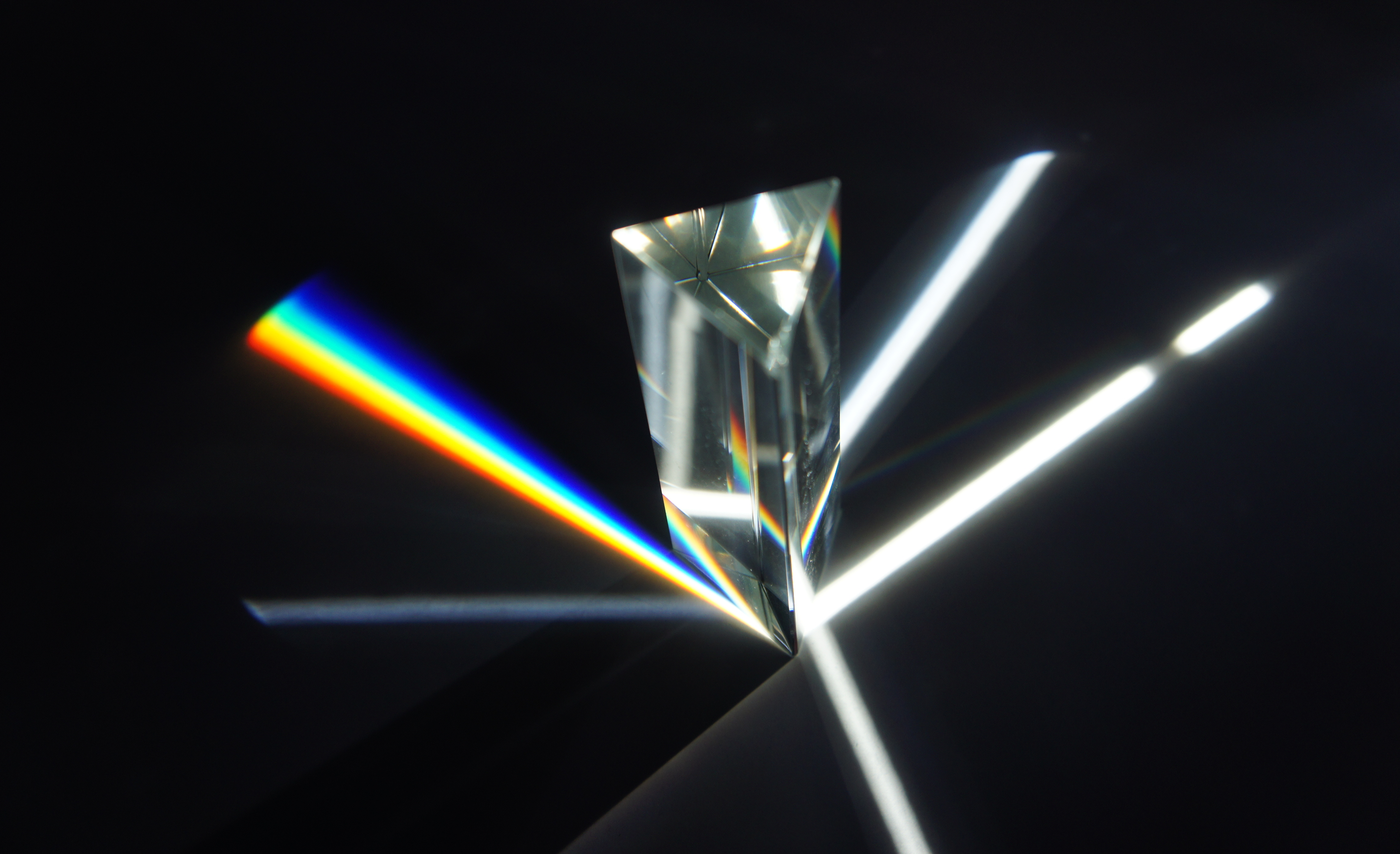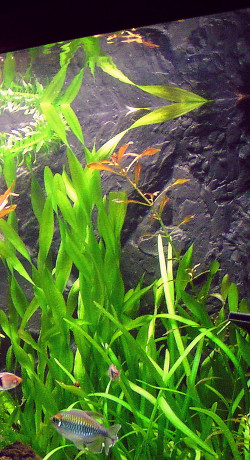|
Bauernfeind Prism
A Bauernfeind prism is a type of reflecting prism used to deviate a beam of light by 45° to 60°, depending on its construction, while neither flipping nor rotating the image. It is named for its inventor, the German expert of geodesy Karl Maximilian von Bauernfeind. The beam is reflected twice in the prism, with one reflection happening at less than the critical angle. Therefore, the prism requires a reflective coating for this surface to be usable in practice. A Bauernfeind prism with 45° beam deviation is also known as a half-penta prism or semipentaprism. A Bauernfeind prism is used together with a Schmidt roof prism to form a Schmidt–Pechan prism. Applications The Bauernfeind prism is commonly used in microscope tubes and in geodesy to deviate the path to the eyepiece in order make the device more ergonomic. More recent applications are glasses that deflect the viewing angle either downwards (for relaxed reading or watching TV), or upwards (as in belay glasses Be ... [...More Info...] [...Related Items...] OR: [Wikipedia] [Google] [Baidu] |
Prism (optics)
An optical prism is a transparent optical element with flat, polished surfaces that are designed to refract light. At least one surface must be angled—elements with two parallel surfaces are ''not'' prisms. The most familiar type of optical prism is the triangular prism, which has a triangular base and rectangular sides. Not all optical prisms are geometric prisms, and not all geometric prisms would count as an optical prism. Prisms can be made from any material that is transparent to the wavelengths for which they are designed. Typical materials include glass, acrylic and fluorite. A dispersive prism can be used to break white light up into its constituent spectral colors (the colors of the rainbow) to form a spectrum as described in the following section. Other types of prisms noted below can be used to reflect light, or to split light into components with different polarizations. Types Dispersive ''Dispersive prisms'' are used to break up light into its ... [...More Info...] [...Related Items...] OR: [Wikipedia] [Google] [Baidu] |
Geodesy
Geodesy or geodetics is the science of measuring and representing the Figure of the Earth, geometry, Gravity of Earth, gravity, and Earth's rotation, spatial orientation of the Earth in Relative change, temporally varying Three-dimensional space, 3D. It is called planetary geodesy when studying other astronomical body, astronomical bodies, such as planets or Natural satellite, circumplanetary systems. Geodynamics, Geodynamical phenomena, including crust (geology), crustal motion, tides, and polar motion, can be studied by designing global and national Geodetic control network, control networks, applying space geodesy and terrestrial geodetic techniques, and relying on Geodetic datum, datums and coordinate systems. Geodetic job titles include geodesist and geodetic surveyor. History Geodesy began in pre-scientific Classical antiquity, antiquity, so the very word geodesy comes from the Ancient Greek word or ''geodaisia'' (literally, "division of Earth"). Early ideas about t ... [...More Info...] [...Related Items...] OR: [Wikipedia] [Google] [Baidu] |
Karl Maximilian Von Bauernfeind
Karl Maximilian von Bauernfeind (28 November 1818 – 3 August 1894) was a German geodesist and civil engineer. Education At the age of 18, Bauernfeind studied under Georg Ohm at the Polytechnic School in Nuremberg. Two years later, he studied mathematics and physics at the Ludwig Maximilian University of Munich and passed the state examination in 1841. Career After gaining practical experience as an engineer during the construction of the Ludwig South-North Railway, he became associate professor of geodesy at the ''Königlich polytechnischen Schule'' in Munich in 1846 and full professor in 1851. In 1846, Bauernfeind presented a new revision of the theory of bridge vaults, which remained authoritative for a long time. Five years later, he invented the prismatic cross (including the Bauernfeind prism), a device that soon became a valuable tool for geodesists because of its accuracy. In 1856, his ''Elemente der Vermessungskunde'' (Elements of Surveying) was published, wh ... [...More Info...] [...Related Items...] OR: [Wikipedia] [Google] [Baidu] |
Total Internal Reflection
In physics, total internal reflection (TIR) is the phenomenon in which waves arriving at the interface (boundary) from one medium to another (e.g., from water to air) are not refracted into the second ("external") medium, but completely reflected back into the first ("internal") medium. It occurs when the second medium has a higher wave speed (i.e., lower refractive index) than the first, and the waves are incident at a sufficiently oblique angle on the interface. For example, the water-to-air surface in a typical fish tank, when viewed obliquely from below, reflects the underwater scene like a mirror with no loss of brightness (Fig.1). TIR occurs not only with electromagnetic waves such as light and microwaves, but also with other types of waves, including sound and water waves. If the waves are capable of forming a narrow beam (Fig.2), the reflection tends to be described in terms of " rays" rather than waves; in a medium whose properties are independent of direction, such ... [...More Info...] [...Related Items...] OR: [Wikipedia] [Google] [Baidu] |
Mirror
A mirror, also known as a looking glass, is an object that Reflection (physics), reflects an image. Light that bounces off a mirror forms an image of whatever is in front of it, which is then focused through the lens of the eye or a camera. Mirrors reverse the direction of light at an angle equal to its incidence. This allows the viewer to see themselves or objects behind them, or even objects that are at an angle from them but out of their field of view, such as around a corner. Natural mirrors have existed since Prehistory, prehistoric times, such as the surface of water, but people have been manufacturing mirrors out of a variety of materials for thousands of years, like stone, metals, and glass. In modern mirrors, metals like silver or aluminium are often used due to their high reflectivity, applied as a thin coating on glass because of its naturally smooth and very Hardness (materials science), hard surface. A mirror is a Wave (physics), wave reflector. Light consists ... [...More Info...] [...Related Items...] OR: [Wikipedia] [Google] [Baidu] |
Schmidt Roof Prism
Schmidt may refer to: * Schmidt (surname), including list of people and fictional characters with the surname * Schmidt (singer) (born 1990), German pop and jazz singer * Schmidt (lunar crater), a small lunar impact crater * Schmidt (Martian crater), a crater on Mars * Schmidt (volcano), in Kamchatka * Schmidt Block, listed on the National Register of Historic Places in Scott County, Iowa, USA * Schmidt Brewery, a St. Paul brewery * Schmidt camera, an astronomical telescope designed for photography * Schmidt–Cassegrain telescope, a version of the Schmidt camera * Schmidt Site, an archeological site in Michigan, USA, listed on the National Register of Historic Places in 1973 * Schmidt Spiele, a German games manufacturer * Schmidt Baking Company, makers of Schmidt's Blue Ribbon Bread * von Schmidt auf Altenstadt, a German baronial family in Kirchgattendorf, part of the municipality of Gattendorf * Schmidt Island, an island in the Novaya Zemlya archipelago in the Arctic Ocean * ... [...More Info...] [...Related Items...] OR: [Wikipedia] [Google] [Baidu] |
Schmidt–Pechan Prism
A Schmidt–Pechan prism is a type of optical prism used to rotate an image by 180°. These prisms are commonly used in binoculars as an ''image erecting system''. The Schmidt–Pechan prism makes use of a roof prism section (from the ). Binoculars designs using Schmidt–Pechan prisms can be constructed more compactly than ones using Porro or Uppendahl roof and Abbe–Koenig roof prisms. A Schmidt–Pechan prism is sometimes called a Pechan prism pair. Method of operation The Schmidt–Pechan is based on the Pechan prism design: Both are a composite of two prisms, separated by an air gap. Because of the air gap there are four glass/air transition surfaces. The Pechan design will invert or revert (flip) the image, depending on the orientation of the prism, but not both at the same time. For the Schmidt–Pechan design, the upper prism from the Pechan design is replaced with a Schmidt roof prism, so the Schmidt–Pechan prism can both invert and revert the image and so a ... [...More Info...] [...Related Items...] OR: [Wikipedia] [Google] [Baidu] |
Microscope
A microscope () is a laboratory equipment, laboratory instrument used to examine objects that are too small to be seen by the naked eye. Microscopy is the science of investigating small objects and structures using a microscope. Microscopic means being invisible to the eye unless aided by a microscope. There are many types of microscopes, and they may be grouped in different ways. One way is to describe the method an instrument uses to interact with a sample and produce images, either by sending a beam of light or electrons through a sample in its optical path, by detecting fluorescence, photon emissions from a sample, or by scanning across and a short distance from the surface of a sample using a probe. The most common microscope (and the first to be invented) is the optical microscope, which uses lenses to refract visible light that passed through a microtome, thinly sectioned sample to produce an observable image. Other major types of microscopes are the fluorescence micro ... [...More Info...] [...Related Items...] OR: [Wikipedia] [Google] [Baidu] |
Eyepiece
An eyepiece, or ocular lens, is a type of lens that is attached to a variety of optical devices such as Optical telescope, telescopes and microscopes. It is named because it is usually the lens that is closest to the eye when someone looks through an optical device to observe an object or sample. The Objective (optics), objective lens or mirror collects light from an object or sample and brings it to focus creating an image of the object. The eyepiece is placed near the Focus (optics), focal point of the objective to magnify this image to the eyes. (The eyepiece and the eye together make an image of the image created by the objective, on the retina of the eye.) The amount of magnification depends on the focal length of the eyepiece. An eyepiece consists of several "Lens (optics), lens elements" in a housing, with a "barrel" on one end. The barrel is shaped to fit in a special opening of the instrument to which it is attached. The image can be focus (optics), focused by moving th ... [...More Info...] [...Related Items...] OR: [Wikipedia] [Google] [Baidu] |
Belay Glasses
Belay glasses are eyeglasses with Porro prism, prismatic lenses that are used by belaying, belayers in rock climbing to avoid the neck strain associated with belaying. Description Belaying involves a person standing on a stable platform below a rock climber controlling the tension and friction of the climber's rope. Since this activity requires craning one's neck to look up at the climber, a common malady named "belayer's neck" can occur. The prismatic lenses of the belay glasses are arranged so as to bend light from above through total internal reflection into the observer's eye, allowing the belayer to observe the climber while maintaining a comfortable head/neck position. The design based on the eyeglasses frame provides for a split field of vision: * the central field through the lenses, providing a vertical view to the climber; * the peripheral field around the sides of the lenses, allowing the belayer to remain aware of their surroundings. Development The first belay glasse ... [...More Info...] [...Related Items...] OR: [Wikipedia] [Google] [Baidu] |





